Inspired by conversations on the Food52 Hotline, we're sharing tips and tricks that make navigating all of our kitchens easier and more fun.
Today: Chef Nick Anderer of Maialino in New York City tells us how to pick the right sauce for our pasta -- and shares a classic recipe.
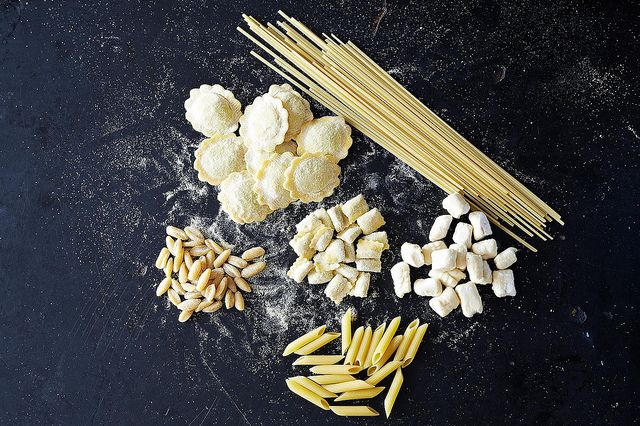
A guest at Maialino once asked me, “Why are you doing cacio e pepe with tonnarelli -- a fresh pasta? Clearly it should be done with dry spaghetti.” I quickly explained that tonnarelli a cacio e pepe was the version I fell in love with in Rome. Period. But surely cacio e pepe has been done successfully with spaghetti -- and many home cooks, both Italian and American, probably know it better in this form due to the availability of dry pasta.
The question -- and my answer -- nagged me for days. What is the right way? What is the traditional way? I am fanatical about sourcing old Italian methods and recipes, not because I think there’s only one right way, but because I am compelled to respect the culinary tradition and the country which is responsible for creating my favorite type of food on the planet. The conclusion I came to -- after some more reading, a few inquisitive emails to the motherland, and some serious self-deliberation -- was that there is simply too much mystery surrounding the tradition of sauce and shape pairings. There could never be one right answer -- and in most cases, traditional sauce and shape pairings occur more out of necessity than science or logic.
While no one can be the definitive authority on what sauce goes with what shape and how to properly combine them, I can explain what has worked for me in my kitchen and share a little bit of my experience with marrying pasta and sauce.
Here are four basic categories which help me dissect the vast pasta world -- and the sauces to pair with them.
Fresh Pasta (Pasta all'Uovo)
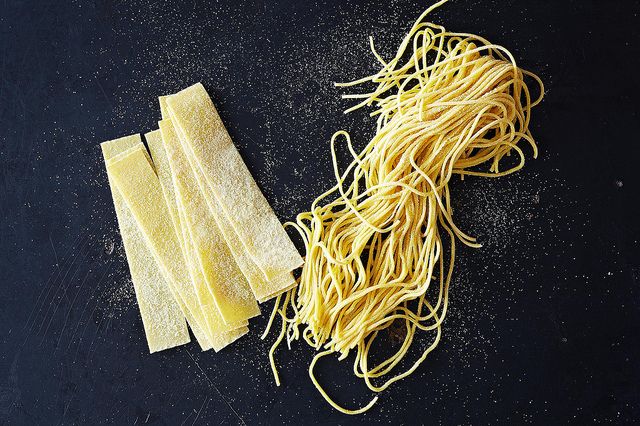
Firstly, there is “fresh” pasta all’uovo, which is generally made with soft wheat (white all-purpose flour) and eggs. The famous types of these pastas -- tagliatelle, pappardelle, fettuccine, lasagne, garganelli -- are never intended to be served al dente, but should instead be tender, smooth and velvety to the touch and to the tooth. Classic pairings often include sauces with dairy or butter, partly because many of these shapes originate in areas of northern Italy, Tuscany and Emilia-Romagna, where cattle are more prevalent. Meat-based sauces and truffles often find their way onto these pastas for the same geographical reasons, and also because truffles taste so friggin' good with butter and cheese.
Dried Pasta

Secondly, there is “dry” pasta acqua e farina -- boxed grocery store pasta -- most commonly made with durum wheat (semolina) and water. Although often misconceived as a product of lesser culinary worth than “fresh” pasta because of its humble ingredients, the best versions of many dry pastas -- spaghetti, bucatini, linguine, rigatoni, bombolotti -- ironically require more technical nuance to produce (bronze dye extraction, controlled dehydration, etc.) and, in my opinion, more savvy to cook. Tomato sauce, capers, olives, anchovies, garlic, and oil are all common companions for many of these shapes, particularly the longer varieties. The shorter versions of these pastas, especially the ring-shaped ones, lend themselves well to sauces with beans, peas or small vegetables, which find cozy little hiding places.
Stuffed Pastas
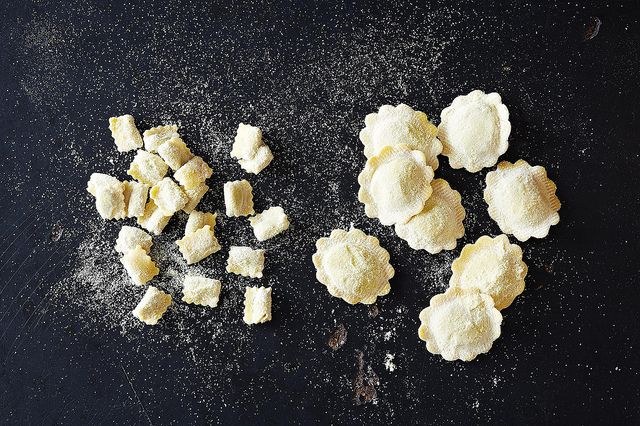
Thirdly, there are “stuffed” pastas, aka ravioli -- agnolotti, mezzalune, tortellini, tortelli -- which generally utilize a “fresh” dough as the casing for some sort of filling (commonly a cheese or a cooked puree of meat/vegetables or some combination thereof). Although it’s also possible to find them boxed in the refrigerated section of grocery stores, let’s just pretend for the moment that those don’t exist. So far as sauce is concerned, the most traditional way of dressing a raviolo is usually the simplest way -- that is to say with as little as possible. Never would you find a sauce made from the contents of its filling, and although tortellini in brodo float in a broth made from the meat which fills them, you would never finds a meat-filled raviolo dressed in a meat sauce. More often than not, ravioli are dressed simply with butter, or brown butter, perhaps with a few leaves of frizzled sage and a squeeze of lemon.
Doughy Pasta

Lastly, there are the “doughy” pastas (a very technical term), which in my world consists of the many shapes -- some with egg, some without -- that are generally handmade, bite-sized, chewy nubs: gnocchi, cavatelli, orecchiette, trofie. Although it’s not a hard and fast rule, these hearty shapes stand up to more aggressive saucing, astringent pestos, bitter greens, sausage and game meats. Yet even with these seasonings, restraint is essential in dressing the noodle. With the painstaking effort that goes into handcrafting these shapes, one wants to be careful that they remain the star of the show.
More: See the recipe for Grandma DiLaura's Italian Ricotta Gnocchi
Making many of these pastas can be tricky, but can be mastered over time with repetition and learned muscle memory. Cooking great pasta is, in my mind, the more difficult task to master and requires a level of extreme fanaticism. Obsessing over perfect ingredients is a good way to kick-start this addiction.
The Best Way to Cook and Sauce Dried Pasta
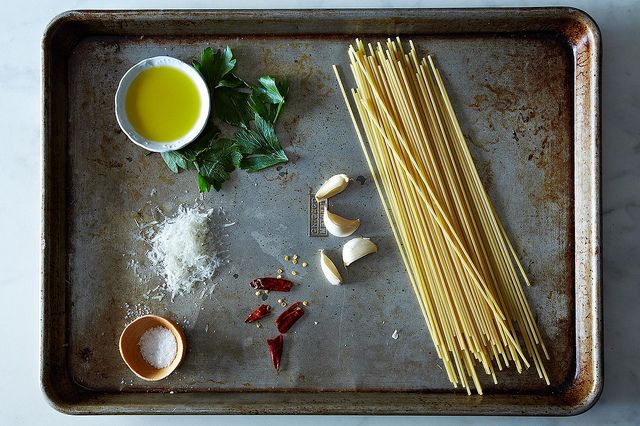
For the purposes of this dialogue, I will expound my love for dry pasta. Of course we need to find the right noodle first. Bottom line: find a pasta with a rough exterior first. Rough means releasable starch and starch equals proper saucing. The next step is testing the pasta with no sauce, simply boiled. Does it break? Does it cook unevenly? Does it go from al dente to mush too quickly?
So you’ve found the right pasta -- let’s skip ahead to the sauce or condimento, which is a much more appropriate word. The first and best pasta cooking lesson I ever received was that all noodles should be dressed like a salad. The noodles are the greens and the sauce is merely a dressing, or a condiment, for the noodle. Spaghetti Agl’Olio is perhaps the best illustrations of this lesson and, when done right, one of the purest expressions of a pasta cook’s ability to marry pasta and sauce. We lovingly refer to it as “the mother sauce” at Maialino, and every cook must master it if he or she is to succeed.
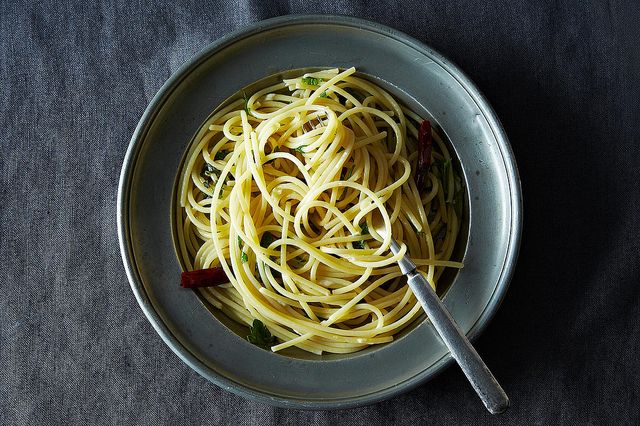
Here's how to make it. Pick your favorite dry spaghetti and cook until al dente in abundantly salted water. Remove it and transfer immediately to a skillet with coarsely chopped parsley, one or two cracked calabrese peperoncini and some thinly sliced garlic, all lightly frizzled in lush, grassy olive oil. Be sure to drag enough pasta water into the pan, both to arrest the sizzling condimenti and to engulf the noodles in enough rapidly simmering broth to perform the magical double duty: (1) extracting starch from the noodles into the sauce and (2) coaxing the flavor of the chili and garlic into the pasta.The pasta water must also be measured (only done accurately by eye and by instinct) so as to not allow the pasta to overcook in the pan, but also so that it can spend enough time in the pan to release its starch -- roughly 45 seconds to a minute. You must be very intimate with your cooking vessels to make this calculation.
At the exact point when all the cooking is reaching its climax, you abruptly cut off the heat so that only one healthy ounce of starchy sauce remains in the pan -- just enough to receive the final application of more fresh olive oil, more fresh parsley, and Parmesan. Now slide the smothered noodles onto a hot plate, yes, a very hot plate, and force yourself to dive in immediately, and with fervor, so that your last bite is nearly as hot as the first. This is pasta at its very best: a simple condimento of carefully sourced ingredients, lovingly prepared with purpose, served and eaten with a sense of urgency.
What are your favorite ways to sauce pasta? Let us know in the comments!








See what other Food52 readers are saying.